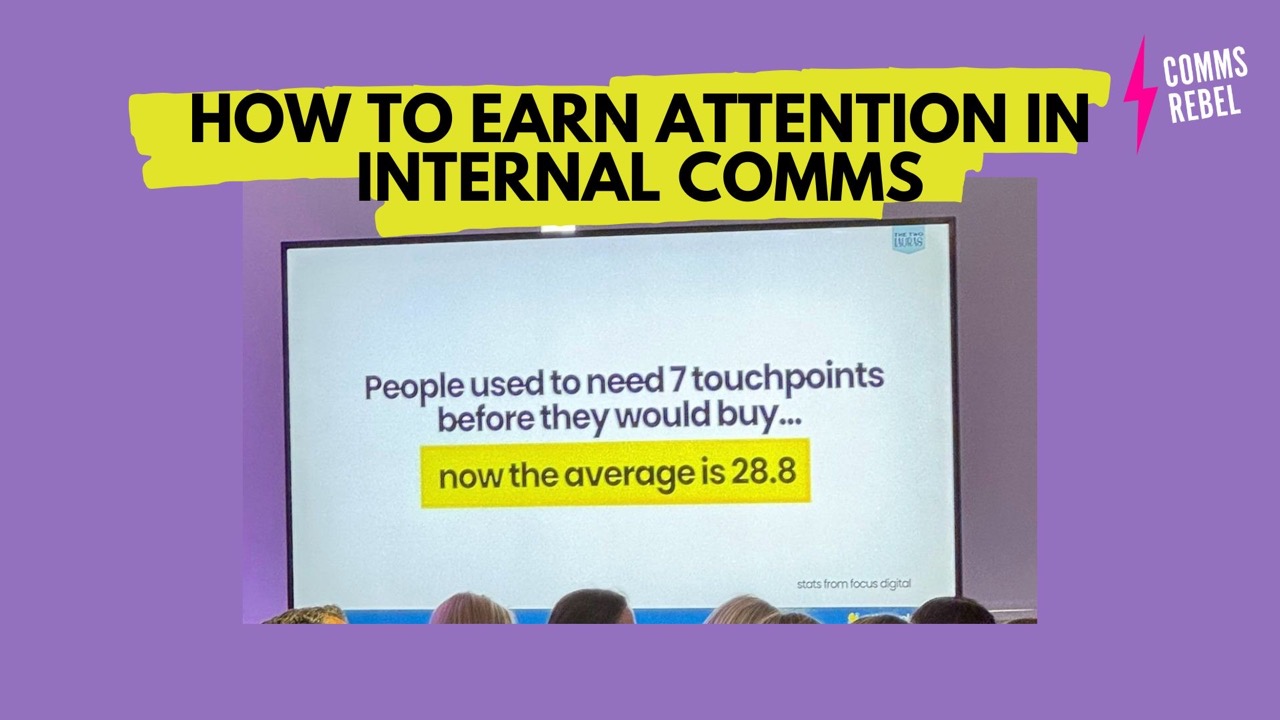28.8.
That’s how many touchpoints, on average, someone needs before they start paying attention.
Let that sink in.
We came across this stat recently and it stopped us in our tracks. According to research by Focus Digital, the number of times someone needs to see or hear a message before it sticks is increasing – and it varies widely depending on your sector:
- Cleaning services: 4.8
- Business services: 16.9
- Training and development: 22.8
- Consulting: 24.9
That’s a lot of repetition. And while the data is drawn from marketing, it’s got huge implications for internal communication.
Because if you’re working in employee engagement, internal comms, or HR, this is your world too.
We often assume that sending a message once is enough. Job done. But the reality is very different. The average workplace is noisy, distracted, and overloaded with information – which means your message probably isn’t cutting through like you’d hoped.
So what can we do?
Let’s dig into what this means for your internal communication strategy – and how to rethink your approach if you want people to not only notice your message, but act on it.
Attention is earned, not assumed
If you’ve ever crafted a carefully written all-staff message, only to get silence (except maybe one person flagging a typo), you’re not alone.
The problem? We often approach internal messaging with a “one and done” mindset. Send it once. Send it to everyone. Then move on to the next.
But if it takes nearly 30 touchpoints to reach people in a busy, distracted environment, then a single message – no matter how well written – is just not going to cut it.
Internal communication isn’t about sending information. It’s about earning attention.
That means building messages that connect, repeat, and evolve over time.
More messages don’t mean more noise
Before we go further, let’s clear one thing up.
This doesn’t mean bombarding employees with endless messages. Spamming your audience into submission is not a strategy, it’s just annoying.
The key is being consistent, purposeful and persuasive. Repetition, when done well, builds recognition and understanding.
So instead of asking, “Have we sent this out yet?”, the better question is:
“How are we building belief in this message over time?”
3 questions to shape more effective internal messages
If you want to reach employees, influence behaviour and improve your internal communication results, start by asking these three questions:
1. What story are we telling?
People don’t remember dry bullet points. They remember stories that connect with them.
So what’s the narrative behind your message? How does it link to something people care about – whether that’s their team, their purpose, or the bigger picture?
Whether it’s a new strategy, a change programme or a campaign, don’t just share what’s happening. Share why it matters.
Use storytelling techniques to take people with you, not just inform them.
2. What’s the real call to action?
Too many internal comms messages try to do too much – or worse, don’t include a clear ask at all.
What do you actually want people to do after reading or hearing this?
Is it to read more? Join a session? Change a behaviour? Speak to a manager? Share feedback?
Be specific. Clear calls to action give your message direction and make it easier for people to engage.
3. How does it matter to the person reading it?
This one’s big. If your message doesn’t feel relevant to the audience, it will be ignored.
Always put yourself in the shoes of your reader. Ask:
- What do they care about?
- How does this impact their day-to-day work?
- What’s in it for them?
This is where personalisation and targeting come in. The more tailored your message, the more chance it has of landing.
If you’re still sending every update to everyone, it might be time to rethink.
Don’t assume visibility equals understanding
Just because a message was sent doesn’t mean it was seen. And just because it was seen doesn’t mean it was understood.
One of the most important shifts we can make in internal communication is moving from outputs to outcomes. Rather than measuring how many messages we send, let’s look at what they actually achieve.
Ask yourself:
- Did people engage with this message?
- Did they understand it?
- Did they do something as a result?
When you start measuring success by outcomes, your messaging becomes sharper, more strategic and more focused on real impact.
Building trust through consistency
Trust isn’t built with one perfect post. It’s built through repeated, credible communication over time.
The best internal communicators know how to play the long game. They don’t rely on one channel or one message. They build a rhythm that feels reliable, human and joined-up.
So don’t worry if your first message doesn’t get immediate traction. Stay consistent. Reinforce the key points. Share updates. Tell stories. Use different channels. Engage managers. Listen to feedback. Then do it again.
That’s how belief is built. That’s how messages stick.
Key takeaways: How to earn colleague attention in a noisy workplace
- People need multiple touchpoints to take action – it’s not enough to say something once.
- One message won’t work for everyone – tailor content to audience needs and roles.
- Build messages over time – use repetition, reinforcement and variety to create cut-through.
- Clarity beats cleverness – focus on clear, relevant stories with a strong call to action.
- Measure outcomes, not just output – look at what people do, not just what they receive.
Internal comms that connects
In a world where attention is scarce, the internal communication that really works is the kind that builds trust, tells a story and makes people feel something.
Not just informed – but involved.
Not just told – but understood.
So next time you’re about to hit send, pause and ask yourself:
“Is this one touchpoint in a wider story, or am I hoping one message will do it all?”
Remember: real communication isn’t a one-off event. It’s a relationship.
PS. If you enjoyed this blog, check out Enhancing Your Visibility as an Internal Communicator.


